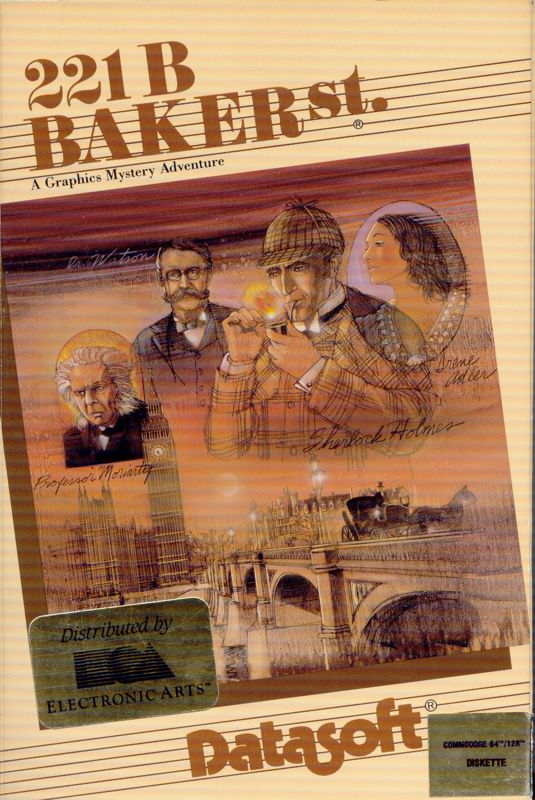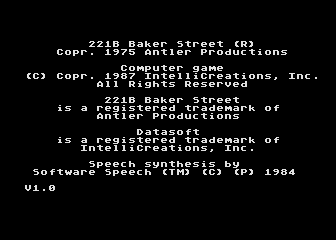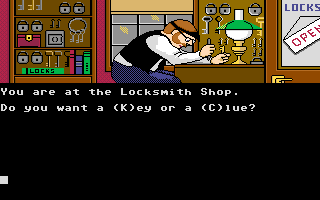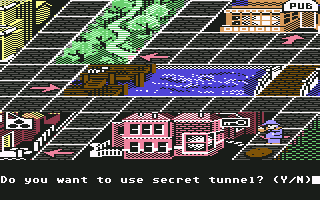Retro Replay Review
Gameplay
221 B Baker St. translates the beloved board game into a turn-based digital experience that captures the essence of Victorian detective work. Upon launching a session, up to four players choose to embody Sherlock Holmes, Dr. Watson, Irene Adler, or Inspector Lestrade, each character bringing subtle dialogue changes and a sense of role-play flair. The game presents thirty distinct cases, each introduced through a detailed case file that outlines the crime, the suspects, and the objective you must deduce. This faithful adaptation requires you to read carefully and plan your investigation strategically.
(HEY YOU!! We hope you enjoy! We try not to run ads. So basically, this is a very expensive hobby running this site. Please consider joining us for updates, forums, and more. Network w/ us to make some cash or friends while retro gaming, and you can win some free retro games for posting. Okay, carry on 👍)
Movement across the map of London is controlled by rolling digital dice, sending you to pubs, parks, banks, and fifteen other atmospheric locations where clues await. Voice synthesis animates each setting with period-appropriate narration, guiding you to the right spot and announcing your discoveries. Not all clues are relevant, so you’ll need to decide whether to visit Scotland Yard early for a badge or save it for locking a clue-rich location against rival sleuths. This badge-locking mechanic adds a layer of strategy, forcing opponents to divert to the locksmith and potentially slowing their progress.
As you gather clues, you’ll jot down notes and cross-reference details to solve the mystery. Once confident in your deductions, you must rush back to Baker Street and take the in-game quiz. A wrong answer sends you back into the fray, while success awards you the case—and bragging rights. The pacing balances luck of the dice with careful deduction, and while solo play offers a comfortable AI challenge, the game truly shines in local or online multiplayer, where outsmarting friends yields lively banter and tense rivalries.
Graphics
Visually, 221 B Baker St. leans into a stylized map of Victorian London. The board is rendered in a muted palette of sepia and dusky blues, evoking gaslit streets and foggy alleyways. Character portraits are crisp, with hand-drawn details on your chosen detective that appear during dialogue and the final quiz. The UI is clean, with icons for dice rolls, badges, and your detective’s notebook clearly displayed at the screen’s edges, helping you focus on the mystery rather than hunting through menus.
Transition animations between locations are brief but effective: a quick crossfade with ambient street sounds for outdoor destinations, and a gentle creak of floorboards when entering an indoor venue. Although there’s no cutting-edge 3D engine at play, the art style complements the game’s board-game roots and keeps the attention on clue gathering rather than flashy visuals. Load times are minimal, ensuring the flow of play isn’t interrupted when traveling between sites.
The voice synthesis narrators lend an old-world atmosphere, even if the robotic timbre occasionally undercuts the mood. Clues are read aloud with proper pacing, and ambient audio—distant chatter in the pub, birds in the park—enhances immersion. While a more polished voice-acting cast might have deepened the drama, the synthesized narration is a charming nod to early computer adventure games and suits the game’s board-game aesthetic.
Story
With thirty unique mysteries to unravel, 221 B Baker St. offers a variety of storylines—ranging from missing heirlooms and cryptic ransom notes to high-profile murders in darkened alleyways. Each case file is written in period-style prose, introducing key figures such as shady pawnbrokers, nervous aristocrats, and mysterious strangers. The narratives are concise yet evocative, providing enough detail to feel lived-in without bogging you down in excessive exposition.
Story complexity varies from straightforward thefts that newcomers can wrap up in a single session to multi-layered murders requiring careful elimination of suspects. The lack of branching paths means that once you solve a case, subsequent playthroughs reveal the same answers, but the randomized clue placement and the badge-lock mechanic keep each investigation feeling fresh. Occasional translation quirks can make certain lines read oddly, but these moments are rare and do little to disrupt the overall narrative thrust.
While the digital format limits dynamic cutscenes, the investigative process itself becomes the core narrative engine. As you piece together clues—perhaps discovering that a harmless bank ledger hides secret ledger entries, or that the park’s flower arrangement masks a dropped handkerchief—you feel the thrill of genuine deduction. The final quiz at Baker Street solidifies the story’s climax, rewarding your logical leaps and punishing any oversights.
Overall Experience
221 B Baker St. hits the sweet spot for fans of deduction and board-game adaptations. The turn-based gameplay, enriched by voice synthesis and atmospheric sound design, captures the social tension of racing fellow detectives to the solution. Local and online multiplayer modes foster engaging back-and-forth, making each session a collaborative yet competitive puzzle. Solo enthusiasts will appreciate the AI’s measured pace and the ability to tackle cases at their own speed.
The presentation is faithful to its tabletop origins, with a clear interface, faithful case files, and a board that feels both nostalgic and fresh. While graphics and voice synthesis aren’t cutting-edge, they serve the game’s design ethos rather than distract from it. The wealth of content—thirty mysteries that typically take 30–45 minutes each—offers strong replay value, especially when playing with different characters who come with subtle dialogue tweaks.
Ultimately, 221 B Baker St. is a must-have for mystery buffs and Sherlock Holmes devotees seeking a digital spin on a classic board-game formula. Its blend of luck, strategy, and deduction creates an addictive loop, whether you’re outmaneuvering friends or methodically eliminating suspects alone. If you enjoy piecing together clues, debating theories with fellow players, and celebrating that “Eureka!” moment when everything clicks, this game delivers a thoroughly engaging Victorian investigation experience.
 Retro Replay Retro Replay gaming reviews, news, emulation, geek stuff and more!
Retro Replay Retro Replay gaming reviews, news, emulation, geek stuff and more!









Reviews
There are no reviews yet.